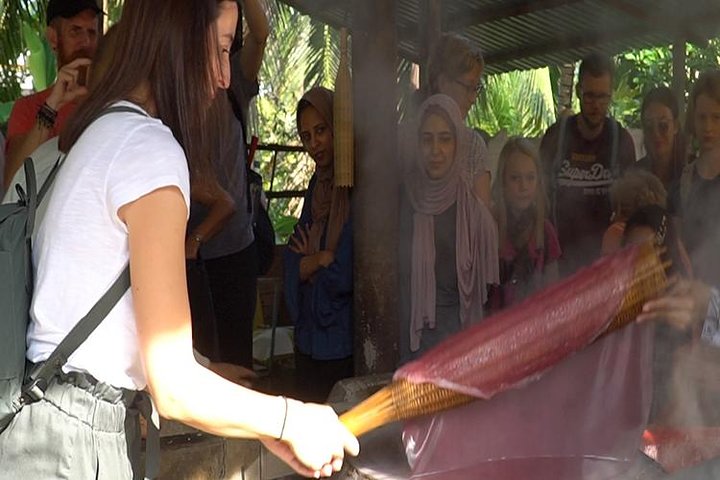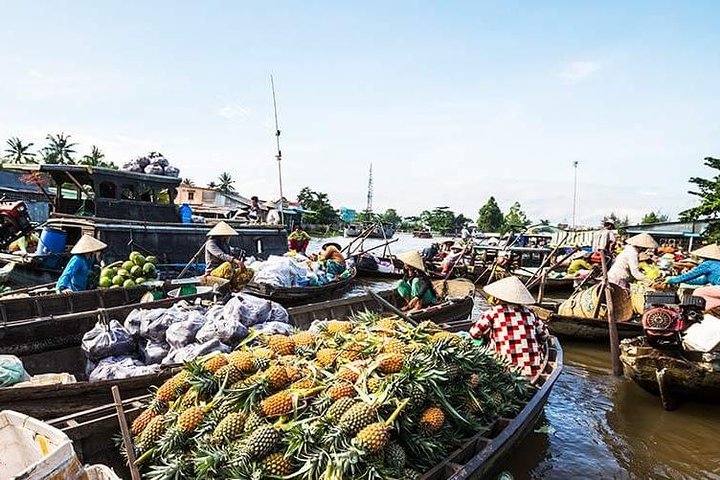- Phu My Port Vietnam - Starting operations 20 years ago in the south of Vietnam, Baria Serece – Phu My Port is being recognized for its high standards in safety, with fast, effective and reliable port services available to the customers 24 hours per day round year. They are strategically located on the Thi Vai River basin, making Baria Serece Phu My Port a great inbound gateway for the cargo that will be distributed within Vietnam, and, also giving to our customers a possibility to outbound cargo thru Asia and world.
Phu My Port is located on Cai Mep-Thi Vai linking-port Road, Phu My District-level Town, Tan Thanh District, Ba Ria Vung Tau Province. Phu My Port is about 40 km from Vung Tau City, 70 km from the center of Saigon, 110 km from Cu Chi Tunnels, 125 km from, Mekong Delta. It takes about 1 hour to Vung Tau City, about 1.5 hours to Ho Chi Minh City, and about 2 hours and 45 minutes to reach My Tho – Mekong Delta from Phu My Port by road way.
You’ll be picked up at main gate of Phu My port to Saigon
-
Binh Tay Market - Located in Chinatown (Cho Lon), Binh Tay Market is a bustling and historic market in Ho Chi Minh City. With a rich history dating back to the late 19th century, the market serves as a vibrant hub of commerce and cultural exchange. Inside its vibrant halls, you can explore a wide range of products including fresh produce, spices, textiles, handicrafts, and more, immersing yourselves in the vibrant atmosphere of this iconic market.
The market was constructed by the French colonial administration to replace the older and smaller Cho Lon Market, which was destroyed in a fire. Binh Tay Market quickly became a thriving commercial center, serving as a vital trading hub for Chinese merchants and the local Vietnamese population.
Over years, the market has witnessed significant transformations. However, it was rebuilt and continues to thrive today, attracting both locals and tourists alike. It remains an essential part of the city’s cultural heritage, offering a diverse array of products.
- Ba Thien Hau Temple - This gorgeous 19th-century temple is dedicated to the goddess Thien Hau, and always attracts a mix of worshippers and visitors, who mingle beneath the large coils of incense suspended overhead. It is believed that Thien Hau can travel over the oceans on a mat and ride the clouds to save people in trouble on the high seas.
There are intricate ceramic friezes above the roof line of the interior courtyard, while the protectors of the pagoda are said to be two land turtles that live here. Near the large braziers stand two miniature wooden structures in which a small figure of Thien Hau is paraded around nearby streets on the 23rd day of the third lunar month.
On the main dais are three figures of Thien Hau, one behind the other, all flanked by two servants or guardians. To the right is a scale-model boat and on the far right is the Goddess Long Mau, Protector of Mothers and Newborns.
Visiting this temple, you will have a chance to discover a part of local culture of an ethnic minority.
-
The Independence Palace - Surrounded by royal palm trees, the dissonant 1960s architecture of this landmark government building and the eerie ambience of its deserted halls make it an intriguing spectacle. The first Communist tanks to arrive in Saigon rumbled here on 30 April 1975 and it’s as if time has stood still since then. The building is deeply associated with the fall of the city in 1975, yet it’s the kitsch detailing and period motifs that steal the show. It’s also known as the Independence Palace.
The building was named Independence Palace and was home to the succeeding South Vietnamese president, Nguyen Van Thieu, until his hasty departure in 1975. Designed by Paris-trained Vietnamese architect Ngo Viet Thu, it is an outstanding example of 1960s architecture, with an airy and open atmosphere.
The Reunification Palace, also known as Independence Palace, is a landmark building located in the heart of Ho Chi Minh City. And it is known as a must see National Monument once you are in Ho Chi Minh City. - PHỞ 24 - 158D PASTEUR - Pho is a traditional Vietnamese soup consisting of broth, noodles, meat, and fresh herbs. It’s unique flavor is made by simmering beef and chicken bones, along with various spices, for hours and hours until the taste is just right.
The history of pho begins at the end of the 19th century, at the peak of French colonialism. French demand led to a greater availability of beef in Vietnam. This in turn produced a surplus of beef bones.
From the early hours, pho stalls set up shop along the sidewalks. Shrouded in clouds of steam, the cook will assemble each bowl to order. Boiling broth is poured over a bed of soft rice noodles and sliced meat, and topped with a handful of chopped herbs and chives. Each diner will customise their bowl to taste, with squeezes of lemon, slices of red chili, sprigs of basil, and dabs of hoisin sauce. It’s an experience no visit to Vietnam is complete without.
Vietnamese Fried Spring Rolls are a popular and tasty appetizer and tasty morsels.
- Sơn mài Đại Việt - The lacquer itself is actually the resin of a tree which is mixed with coloured pigments and solvents and applied layer after layer to the object’s surface, producing a shiny and durable finish. Eggshell and mother of pearl may be applied to the surface before the lacquer is applied, in which the finished product is sanded down to reveal the decoration beneath.
The high quality of resin from Vietnamese lacquer trees, notably those of Phu Tho, was a crucial factor in the rapid development of this art form during the feudal period.
Decorated lacquer statues, panels, boxes and trays (1428-1527), may still be seen at many temples and pagodas.
In subsequent centuries the use of lacquerware was extended to larger items such as wooden chairs and tables.
Since that time lacquerware has continued to develop into one of the mainstays of the Vietnamese handicraft industry, both at home and abroad. Today’s most popular items include vases, jewel cases, desk sets, trays and vertical blinds.
- History Museum of Ho Chi Minh City - Built in 1929, this notable Sino-French museum houses a rewarding collection of artefacts illustrating the evolution of the cultures of Vietnam, from the Bronze Age Dong Son civilization (which emerged in 2000 BCE) and the Funan civilization (1st to 6th centuries CE) to the Cham, Khmer and Vietnamese. Highlights include valuable relics taken from Cambodia’s Angkor Wat and a fine collection of Buddha statues. There’s good English information. Parts of the museum are being renovated.
There’s also a perfectly preserved mummy of a local woman who died in 1869, excavated from Xom Cai in District 5; and some exquisite stylised mother-of-pearl Chinese characters inlaid into panels. It’s located beside the Botanical Gardens.
The museum also encompasses the diverse cultures of ethnic groups in Southern Vietnam and other Asian countries. Explore their clothing, unique musical instruments, statues of deities, and tools related to agriculture, hunting and fishing.
- Phu My Port Vietnam - Starting operations 20 years ago in the south of Vietnam, Baria Serece – Phu My Port is being recognized for its high standards in safety, with fast, effective and reliable port services available to the customers 24 hours per day round year. They are strategically located on the Thi Vai River basin, making Baria Serece Phu My Port a great inbound gateway for the cargo that will be distributed within Vietnam, and, also giving to our customers a possibility to outbound cargo thru Asia and world.
Phu My Port is located on Cai Mep - Thi Vai linking - port Road, Phu My District-level Town, Tan Thanh District, Ba Ria Vung Tau Province. Phu My Port is about 40 km from Vung Tau City, 70 km from the center of Saigon, 110 km from Cu Chi Tunnels, 125 km from, Mekong Delta. It takes about 1 hour to Vung Tau City, about 1.5 hours to Ho Chi Minh City, and about 2 hours and 45 minutes to Mekong Delta from Phu My Port by road way.
You’ll be dropped off at main gate of Phu My port from Saigon.

- Entrance fees
- Air-conditioned vehicle
- Bottled water
- English Speaking Tour Guide
- Pick up/ Drop off at Phu My Port
- Tipping/ Gratuities or personal expenses
Ho Chi Minh City, also known as Saigon and long regarded as the Pearl of the Far East, is Vietnam’s most dynamic hub of commerce and culture. Visiting Saigon is like experiencing a blend of exotic, delicious food and French colonial architecture.
A state-run handicraft enterprise exports a variety of products—including furniture, carpets, lacquer paintings, and other artworks—primarily made from local materials, and you will get to see part of this attraction. Pho noodle soup and spring rolls are renowned as two of the most quintessential traditional Vietnamese dishes that are considered must-try foods.
There are numerous incredible attractions such as the largest Binh Tay wholesale market, where you can learn about doing business in Vietnam; the oldest Thien Hau Holy Lady Temple in Saigon; the Ho Chi Minh City Central Post Office, known as the Center of Telegraph during the Indochina War; or explore the National Monument of Reunification Palace or the Vietnam History Museum to learn more about Vietnam’s history.
- The remaining hours are allotted for the travel time
- Everyone can join this tour
For a full refund, cancel at least 24 hours before the scheduled departure time.



































